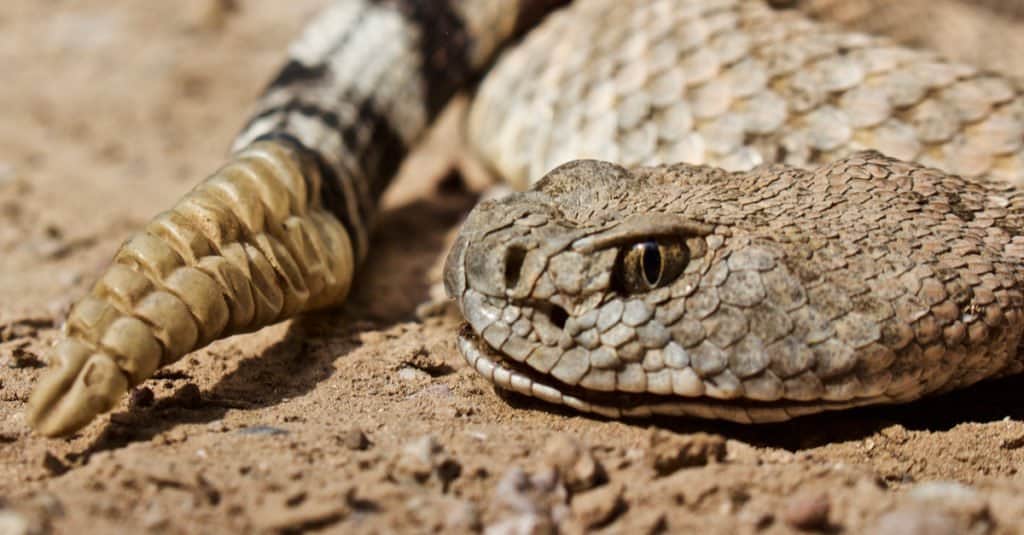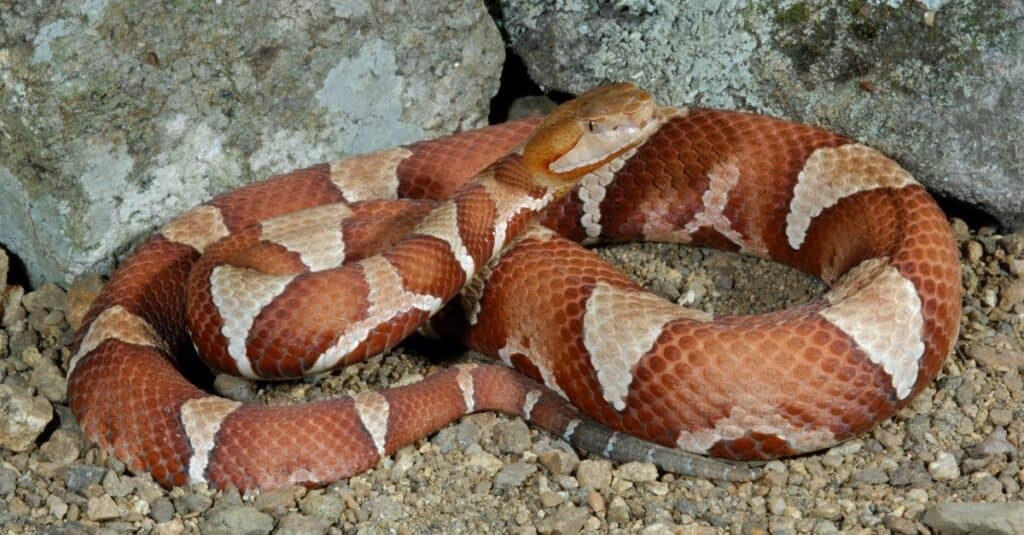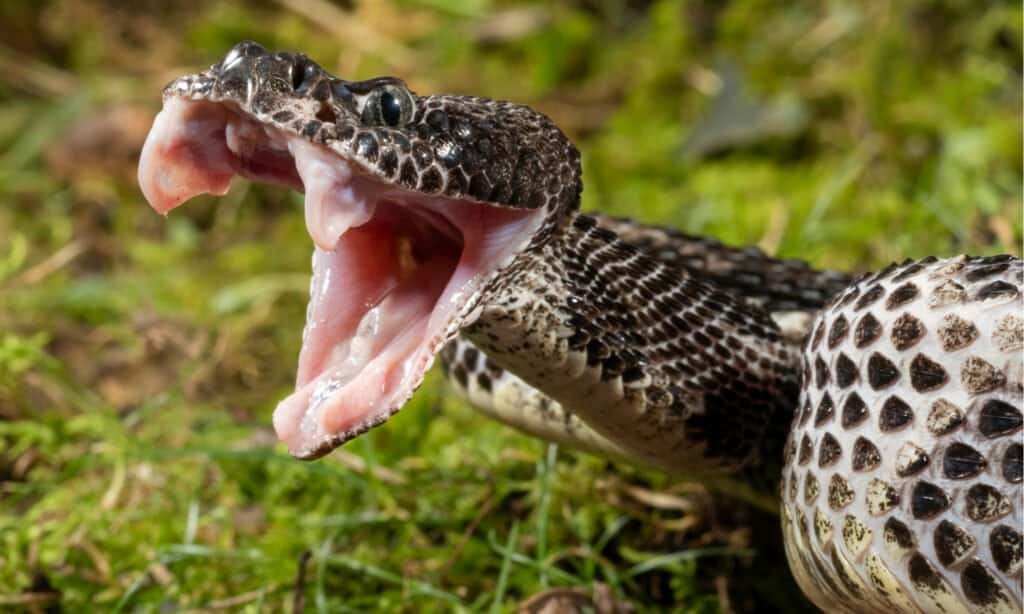If you love the great outdoors, Nebraska may be the vacation destination you are looking for this summer. This state is well-known among hikers, campers, fishermen, and hunters for its gorgeous scenery! However, the hidden danger of venomous snakes lurks in Nebraska’s natural splendor.
It is time to find out the top four largest (and most dangerous) snakes in Nebraska!
The Top Four Largest (And Most Dangerous) Snakes In Nebraska
Of Nebraska’s four largest and most dangerous snakes, three of them are rattlesnakes! In this section, we will start with the smallest and work our way to the largest. Coincidentally, the largest snake on this list is not just the biggest; it is also the most venomous snake in the United States!
The Western Massasauga Rattlesnake

Western species of the massasauga rattlesnake are the smallest venomous snakes in Nebraska.
©Rusty Dodson/Shutterstock.com
Size: 18-26 inches long.
Locations: Prairies, grasslands, and marshlands.
Danger: Venomous; bite is highly dangerous without medical treatment.
Behavior: Moderately aggressive but will strike if provoked. Most bites occur through accidental contact.
Western massasauga rattlesnakes are pale brown or tan overall with darker mottling that appears blurred or muted. Unlike other rattlesnake species, the western massasauga has nine distinctive large scales on the top of its heads.
This species is only found in the extreme southeastern corner of Nebraska and is classified as Threatened by the state.
The Prairie Rattlesnake

The prairie rattlesnake is the third-largest venomous snake in Nebraska.
©DMartin09/Shutterstock.com
Size: 35-45 inches long.
Locations: Grasslands, plains, foothills, and mountains.
Danger: Venomous; bite can be deadly without medical treatment.
Behavior: Moderately aggressive. Bites occur due to accidental contact or provocation.
Prairie rattlesnakes are light brown, grey, or green overall, with darker mottled markings. There are thirty-two kinds of prairie rattler, and markings range from brown, tan, or white, depending on the species. While they are smaller than the diamondback species, they are sometimes confused with each other. The prairie rattlesnake has a thinner body and lacks distinct facial markings common in diamondbacks.
This species is found exclusively in Western Nebraska.
The Copperhead

The copperhead is the second largest and most dangerous snake in Nebraska.
©Breck P. Kent/Shutterstock.com
Size: 24-36 inches long.
Locations: Rocky/high elevations, marshlands.
Danger: Venomous bite that can be deadly without prompt medical treatment.
Behavior: Blends well with surrounding habitat and is known to strike with little or no warning. However, this species is not known to be overly aggressive, and most bites occur through accidental contact.
Copperheads are identified by their distinctive reddish-brown overall coloring and brown hourglass-shaped markings. Like most species of pit viper, the copperhead has a narrow, triangular-shaped head and catlike eyes with slitted pupils.
In Nebraska, copperhead sightings only occur in southern Gage and Richardson Counties. However, experts have speculated that copperheads may also be found near the Missouri River bluffs, south of Platte River.
The Timber Rattlesnake

Timber rattlesnakes are the largest and most dangerous snakes in Nebraska,
©Joe McDonald/Shutterstock.com
Size: 36-60 inches long.
Locations: Forests, farms, and lowlands.
Danger: Highly Venomous and deadly without prompt medical intervention.
Behavior: An aggressive ambush hunter that gives little warning before striking.
The timber rattlesnake is the second-largest rattlesnake in the United States and has the most concentrated and deadly venom in the country. This species can be identified by its reddish-brown banded coloring and yellow-grey or black markings. These markings progress down the back and end in V-shaped crossbands at the tail.
This species is only found in the extreme southeastern corner of Nebraska and is classified as threatened by the state. Unlike other species of rattlesnake, experts recommend running away from this snake immediately. The timber rattler is known for aggression and little warning prior to striking!
How To Know If A Snake Is Venomous Or Not
When encountering a snake, the priority should always be retreating a safe distance away. The safest course of action is to assume any snake is a venomous snake!
However, in situations where you need to report a venomous snake in a populated area, it is important to know what to look for. Identifying a specific species may be difficult, especially during a stressful situation. Luckily, there are quite a few key features that venomous snakes of most species have in common!
Identifying A Venomous Snake In Nebraska
- Blotching Or Banded Patterns: Most of Nebraska’s venomous snakes have these types of markings. Non-venomous snakes in the state all have lengthwise striped markings. However, the Timber Rattlesnake may have a single rust-red stripe!
- Triangular Head Shapes: Nebraska’s venomous snakes have this head shape, which is significantly wider at the neck and narrower at the mouth. However, some species such as garters, hognoses, and bull snakes may also display this shape as well.
- Slitted, “Catlike” Pupils: Nebraska’s venomous snakes all have slitted pupils, whereas non-venomous snakes have rounded eyes and pupils.
- Pit Markings Near The Nostrils: All four of Nebraska’s venomous snakes are pit vipers. The pit looks like a larger nostril on both sides of the head.
- The Warning Rattle: Except for the copperhead, Nebraska’s venomous snakes are all rattlesnakes. But remember, the timber species only give a brief warning before striking!
| Snake | Size |
|---|---|
| Western Massasauga Rattlesnake | 18-26 inches long |
| Prairie Rattlesnake | 35-45 inches long |
| Copperhead | 24-36 inches long |
| Timber Rattlesnake | 30-60 inches long |
The photo featured at the top of this post is © Scott Delony/Shutterstock.com
Discover the "Monster" Snake 5X Bigger than an Anaconda
Every day A-Z Animals sends out some of the most incredible facts in the world from our free newsletter. Want to discover the 10 most beautiful snakes in the world, a "snake island" where you're never more than 3 feet from danger, or a "monster" snake 5X larger than an anaconda? Then sign up right now and you'll start receiving our daily newsletter absolutely free.
Thank you for reading! Have some feedback for us? Contact the AZ Animals editorial team.






